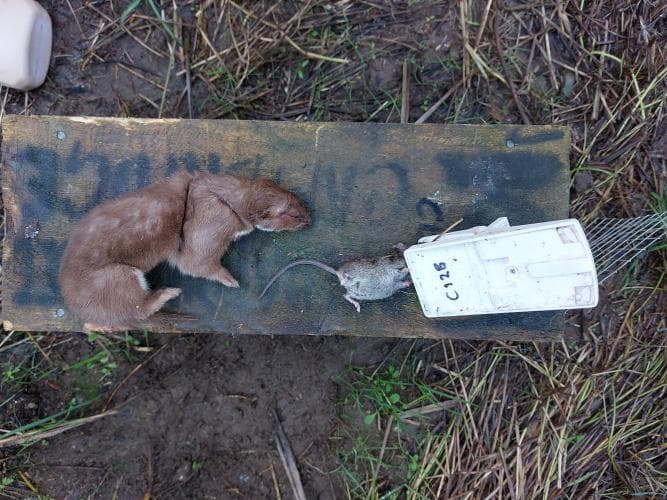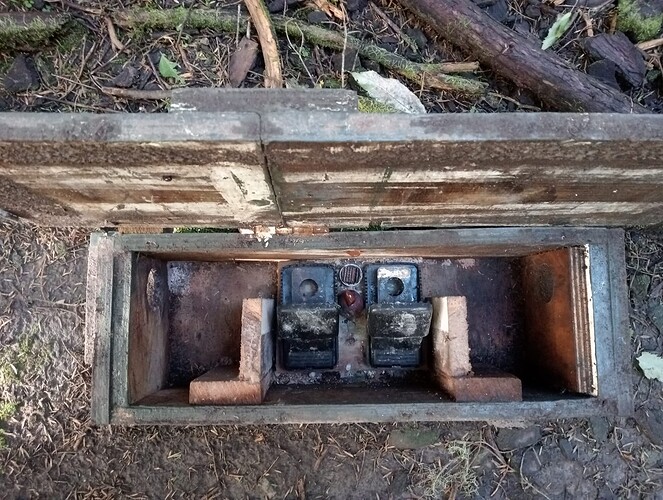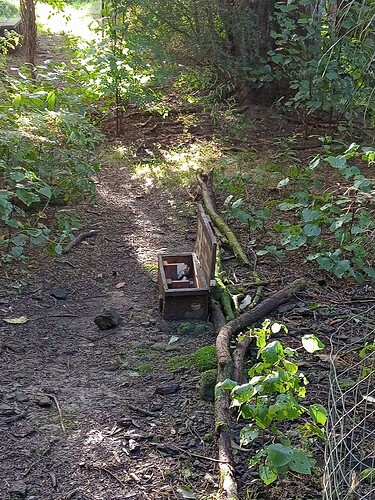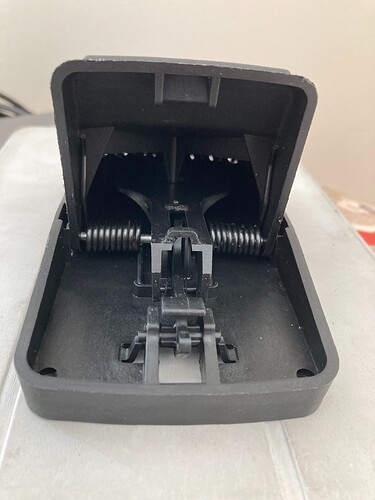You’re right about snap traps not being as effective as DoC tunnels with brown rats. That being said, I still kill a significant number of browns with them.
I’ll only use poison if it’s absolutely necessary, like a rat doing damage to the house that I’m unable to trap. Last year, I resorted to putting poison in a bait station, but killed the rat before it had a chance to eat any. Whew!
Because they’re more neophobic than ship rats, the body of another brown rat is the best lure to use, in my experience (I don’t know if a toxin in the body of a lure rat would affect its appeal to live rats). If there’s a trap wary rat around, placing a freshly killed brown rat from another site inside the tunnel that’s being ignored, will often kill the trap wary rat that night. Wearing gloves, I rub the fur of the lure rat on the entrance to the tunnel and through the baffle, to make it appear as though the lure rat actually entered the tunnel.
I can state with certainty that this technique works, because when I’ve had to deal with a “problem rat”, the ones that make burrows under our deck, the activity ceases once the rat has been killed in the tunnel that it previously refused to enter. Often, the bastards will tease me by eating the lures that I put at the entrance to the tunnel, but won’t take the next step and go inside, which is extremely frustrating.
I’ve also trapped some brown rats in cages but removing them from a cage and killing them isn’t for the fainthearted! A few hammer blows do the trick and I keep my dog nearby to get the rat if it tries to escape.
An unconventional way that I’ve killed a number of brown rats, is by using firm blocks of white fat as lures in my Timms traps, which I’ve been using as cat lures. You know it’s a big rat when it can set off a Timms! If you don’t have any pets around, this is definitely worth trying. The large entrance to a Timms is far less intimidating to a rat than entering a tunnel, and they can’t resist the fat. Even moldy pieces that I thought had to be removed, have done the trick. If there’s still a decent amount of good fat in the block, rats will chew through the mold to get at it, despite the claims that rats refuse to consume moldy foods. Thus far, this technique has only worked for me in the winter, when food supplies are low, so trapping rats at other times of the year this way could/should be less effective. It does increase the odds that cats and mustelids have access to the fat in the Timms, which is a good thing.
To extend the field-life of the fat blocks, I give them a quick fry in the pan. The cooked outer layer gives the pieces of fat a greasy coating that’s mold-resistant and it enhances their smell. A cold block of white fat is hard to smell, even when you hold it up to your nose. Obviously, rats (and the other predators) have a way stronger sense of smell than humans do, but the scent of cooked fat in the air should be way, way easier for them to detect at a distance.
I have yet to trap a large stoat or a ferret using white fat in Timms, but I think that it’s only a matter of time. Mustelid numbers are unusually low right now, so I may have to wait a while.
On several occasions, brown rats have walked right past a tunnel containing an assortment of gourmet lures and been killed in the Timms 1m away. Trap clusters are an effective way to kill a range of species at the same site. Expert trapper Cam Speedy advises trappers to use them.
Regarding using gloves, I don’t know how big a difference it makes. There exist a % of predators that are so neophobic, that the smell of a human on a trap/tunnel/lure may be the deal-breaker. If wearing gloves increases the number of trap wary rats, mustelids or cats getting killed by 10%, it’s worth the inconvenience to me. I doubt that wearing gloves when trapping predators would be standard practice if it didn’t make a difference.
While the risk of catching a disease from handling predators is quite low, I’d rather not find out the hard way that gloves could have prevented an illness. It’s definitely a good idea to wear gloves when you’re handling raw lures.
Safety-wise, leather gloves can lessen the blow of an injury to some degree, especially if a trap has teeth.
I’ve never had a Goodnature lure go moldy, because they’ve never lasted long enough for that to happen. I haven’t had much success with the choc or nut lures, but I’ve killed masses of pests with the meat-lover’s. I’ve killed some rats with the cinnamon lure, though, so firing some in your tunnels a few times a year might get some results as a curiosity lure.
I’m also trying to trap more cats. I know that this will come as a shock, but I recommend using blocks of white fat as a cat lure. One thing that you have to do is use a knife to make a hole in the middle of a piece, because trying to skewer it without doing so is nearly impossible.
In warm and hot weather, giving flesh/fat lures a coating of Goodnature’s Meat-Lover’s lure is an effective way to reduce insect interference. For whatever reason, insects have no interest in it, but predators love it. A coating gives of it gives lures some protection from the weather, too, because it’s water-resistant.
Last summer, I discovered that MLL can keep lures fresh longer than if they’re left bare, because it helps to retains their moisture. I did a side-by-side comparison with 2 Timms and the difference was night and day. You could smell the rank, blowfly maggot-infested block from 50m away on the breeze, while the coated lure didn’t smell and didn’t have any signs of maggots. Which Timms killed the cat? The one with the coated lure.
Note: MLL doesn’t smell. When I first tried it, I e-mailed Goodnature to ask if I’d bought a bad batch, but they said that something would be wrong with the lure, if I could smell it.
I hope that you have success killing cats. They’re sods of things to kill.
Cheers.





